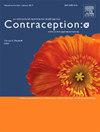不满意的避孕选择在美国妇女中由于成本
Q2 Medicine
引用次数: 15
摘要
目的探讨首选避孕药具使用成本障碍的患病率和特点。研究设计在2015-2017年具有全国代表性的有意外怀孕风险的女性样本中,我们使用泊松回归来评估在没有成本的情况下偏好(另一种)方法的相关特征。结果总体而言,22%的人倾向于使用另一种方法。使用效果较差的方法的女性,年龄在15-24岁、收入较低的黑人或西班牙裔女性,更有可能报告成本障碍。结论择优避孕是获得护理和生殖自主的一个指标。这些结果为跟踪政策变化的影响提供了一个基准。本文章由计算机程序翻译,如有差异,请以英文原文为准。
Unsatisfied contraceptive preferences due to cost among women in the United States
Objectives
To examine prevalence and characteristics associated with cost barriers to preferred contraceptive use.
Study design
Among a nationally representative sample of women at risk of unplanned pregnancy in 2015–2017, we used Poisson regression to assess characteristics associated preferring a(nother) method in the absence of cost.
Results
Overall, 22% preferred to use a(nother) method. Women using less-effective methods, who were Black or Hispanic, ages 15–24 and had low incomes, were more likely to report cost barriers.
Conclusions
Using a preferred method is an indicator of access to care and reproductive autonomy. These results provide a benchmark to track the impact of policy changes.
求助全文
通过发布文献求助,成功后即可免费获取论文全文。
去求助
来源期刊

Contraception: X
Medicine-Obstetrics and Gynecology
CiteScore
5.10
自引率
0.00%
发文量
17
审稿时长
22 weeks
 求助内容:
求助内容: 应助结果提醒方式:
应助结果提醒方式:


